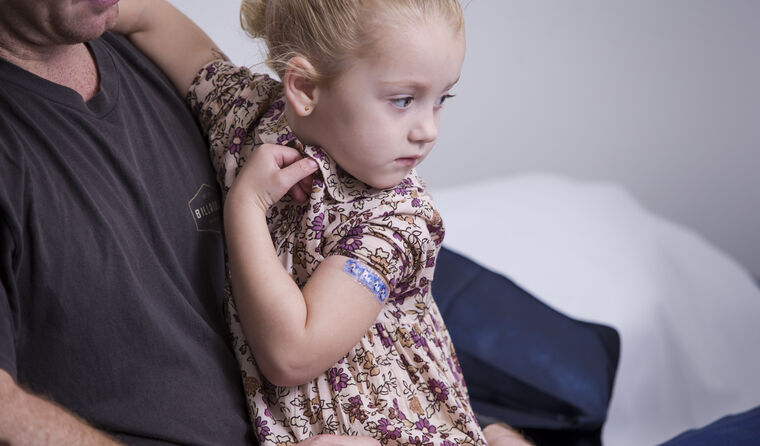News
Australian child vaccination rates continue to fall
Many jurisdictions are close to the herd immunity threshold for highly infectious diseases like measles, with some areas especially vulnerable.
 Some areas in Australia have fallen below an 80% average rate of full immunisation.
Some areas in Australia have fallen below an 80% average rate of full immunisation.
Childhood vaccination rates have again dropped in Australia, with the last quarter report showing declines across most age groups in nearly every state and territory.
According to the latest figures from the Australian Immunisation Register, national rates of fully vaccinated one-year-olds and five-year-olds fell by 0.1% between September and December 2023, while two-year-old immunisations rose by 0.02%.
Dr James Best, Chair of RACGP Specific Interests Child and Young Person’s Health, told newsGP anxiety around the COVID vaccination rollout has ‘potentially shifted people’s attitude’ towards immunisation and parts of Australia are now vulnerable to disease.
‘Those areas in Australia where there are significantly lower vaccine rates in children can act as a gateway for diseases to come into the country that weren’t already here, through travel, or spread more widely the ones that are here,’ he said.
Averages have fallen across all age groups since peaking in 2020, despite new research showing that vaccination has saved approximately 154 million lives globally, mostly children under five, since 1974.
The research was released to mark the 50-year anniversary of the international Expanded Programme on Immunisation (EPI), which Associate Professor Andrew Shattock, who led the study, described as ‘the single greatest contribution to infant survival over the past 50 years’.
He also estimates that immunisation has saved around 146 million children under the age of five over the same period.
‘In 2024 a child at any age under 10 years is 40% more likely to survive to their next birthday thanks to [these] vaccination efforts,’ Associate Professor Shattock said.
‘For every death averted, 66 years of full health were gained on average.’
Australia was surpassing the national benchmark in 2021.
Measles vaccination accounted for 60% of the total benefit of vaccination over the 50-year period and was identified as ‘the greatest driver of lives saved’.
However, while the Department of Health and Aged Care website states coverage needs to reach more than 92% for herd immunity against highly infectious diseases like measles, Australia’s MMR vaccination rate sits at only 92.65%.
Western Australia (91.36%) and Queensland (91.93%) were both slightly below the measles herd immunity threshold in December 2023. Australia’s western-most state also had the lowest immunisation rates for one-year olds at 92.12% and two-year olds at 89.74%, with the Northern Territory having the lowest rates for five-year olds at 92.14%.
And while kids in remote Arnhem Land sit above the national benchmark for one- and two-year-old vaccinations, children in Richmond Valley, the Gold Coast Hinterland and Noosa sit between 74.72% to 81.87%.
GP Dr Leanne Jones, who is on the Board of the Immunisation Coalition, told newsGP there are areas in Australia with growing numbers of conscientious objectors.
‘It came to the fore during COVID, of course, with people who question vaccination and the benefits of it,’ she said.
But Dr Jones said there is also a danger that people are getting into a ‘vaccine exhaustion’.
‘We’ve had all these COVID vaccinations, now we’ve got shingles, and it’s time for influenza,’ she said.
‘This is all sort of concentrating on our senior citizens, though we still have to remember our children.’
Dr Jones encouraged GPs to check the vaccination status of all children who come to see them but noted not all of them have the time or extra staff who could check.
‘People don’t often know what these diseases are because they’ve never seen them and therefore, they don’t think they exist and they’re not important,’ she said.
‘We can’t drop the ball on it.’
However, Dr Best said GPs must keep the conversation going.
‘We’ve got to keep trying to talk to those that are vaccine hesitant and explain the importance of vaccination and the reasons why we’re doing it and also alleviate any concerns or anxiety that people have about getting their child vaccinated,’ he said.
The Australian Capital Territory was the one jurisdiction that exceeded the 95% target rate for one-year-old immunisation coverage.
South Australia and the ACT exceeded 95% for five-year-old immunisation coverage.
At December 2023, the national coverage rates were:
- 93.16% for all one-year-olds
- 91.24% for all two-year-olds
- 93.93% for all five-year-olds.
Some of the lowest vaccination regions in the country nearing, or below, 80% are:
- NSW Richmond Valley – Coastal: two- year-old vaccinations at 74.72%
- NSW Richmond Valley – Coastal: one-year-old vaccinations at 79.22%
- QLD – Gold Coast Hinterland: five-year-old vaccinations at 79.82%
- QLD Noosa: two-year-old vaccinations at 81.09%
- SA Outback – North and East: two-year-old vaccinations at 81.50%
- NT Barkly: one-year-old vaccinations at 81.67%
- QLD Gold Coast Hinterland: one-year-old vaccinations at 81.87%
- WA Pilbara: two-year-old vaccinations at 82.15%
- NSW Richmond Valley – Coastal: five-year-old vaccinations at 82.25%
- QLD Maroochy: two-year-old vaccinations at 82.40%
- QLD Surfers Paradise: two- year-old vaccinations at 83.44%
- WA Augusta – Margaret River – Busselton: two-year-old vaccinations at 82.53%
- WA Augusta – Margaret River – Busselton: one-year-old vaccinations at 83.95%
Log in below to join the conversation.
childhood immunisation children’s vaccination measles MMR vaccination vaccine preventable disease vaccine rollout vaccines
newsGP weekly poll
Health practitioners found guilty of sexual misconduct will soon have the finding permanently recorded on their public register record. Do you support this change?